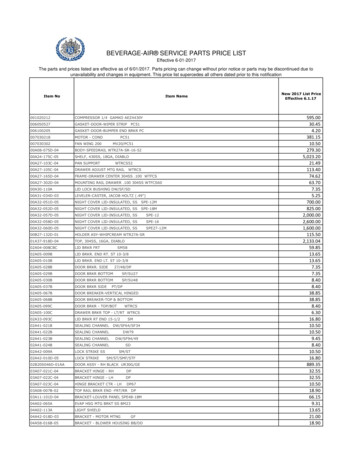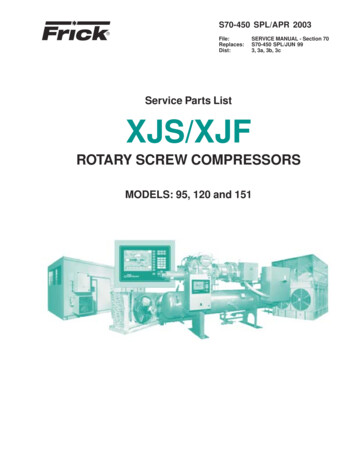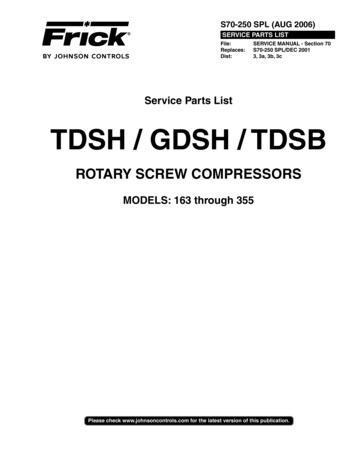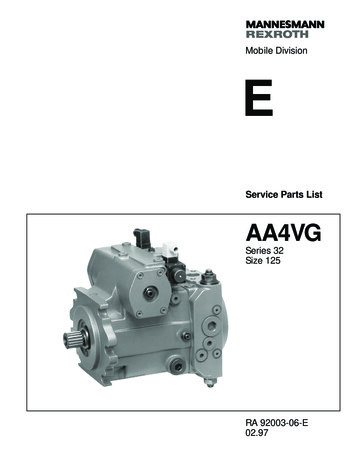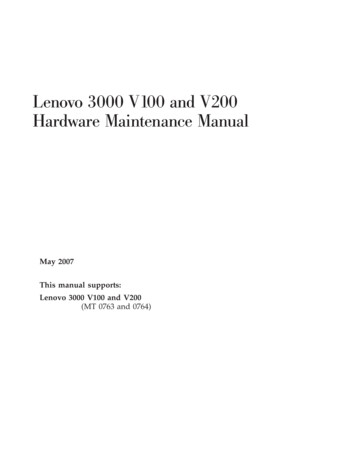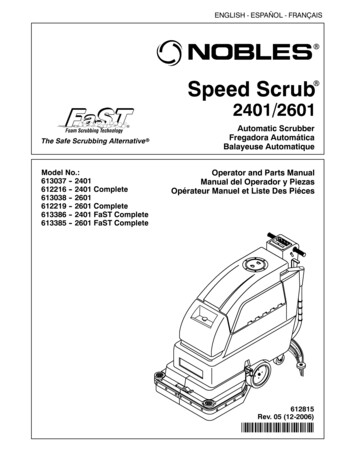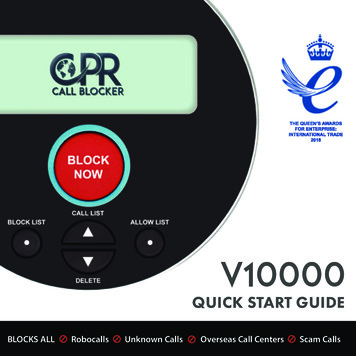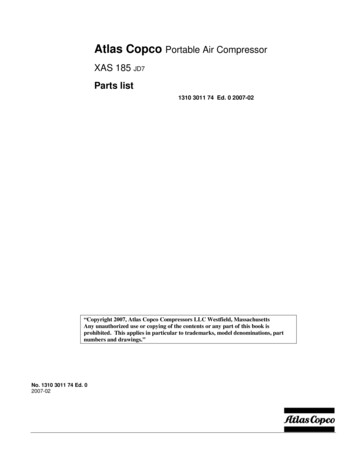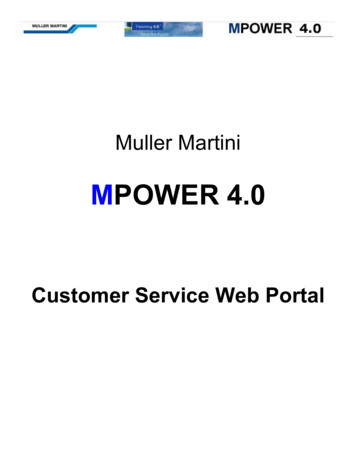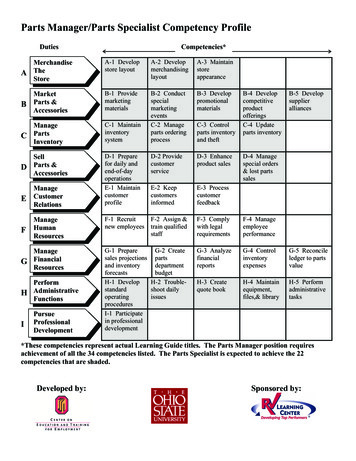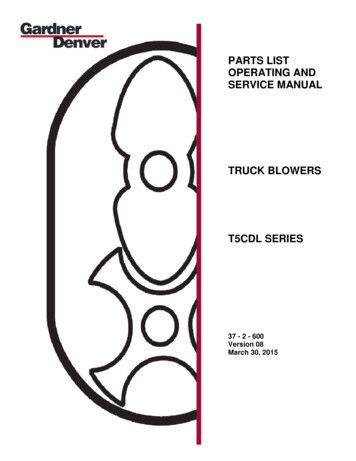
Transcription
PARTS LISTOPERATING ANDSERVICE MANUALTRUCK BLOWERST5CDL SERIES37 - 2 - 600Version 08March 30, 2015
MAINTAIN BLOWER RELIABILITY AND PERFORMANCE WITH GENUINE GARDNERDENVER PARTS AND SUPPORT SERVICESFactory genuine parts, manufactured to design tolerances, are developed for optimumdependability ------ specifically for your blower Design and material innovations are born fromyears of experience with hundreds of different blower applications When you specify factorygenuine parts you are assured of receiving parts that incorporate the most current designadvancements manufactured in our state-of the- art blower factory under exacting qualitystandardsYour AUTHORIZED DISTRIBUTOR offers all the backup you require A worldwide network ofauthorized distributors provides the finest product support in the blower industry1 Trained parts technical representatives to assist you in selecting the correct replacementparts2 Complete inventory of new machines and new, genuine factory parts3 A full line of factory tested AEON PD blower lubricants specifically formulated foroptimum performance in all blowers4 Authorized distributor service technicians are factory--trained and skilled in blowermaintenance and repair They are ready to respond and assist you by providing fast,expert maintenance and repair servicesFor the location of your local authorized Gardner Denver blower distributor refer to theyellow pages of your phone directory, check the Web site at www.gardnerdenver.com orcontact:Gardner Denver Compressor Division1800 Gardner ExpresswayQuincy, IL 62305Phone: (217) 222--5400Fax: (217) 221--8780INSTRUCTIONS FOR ORDERING REPAIR PARTSFor pricing, and ordering information contact your nearest AUTHORIZED FACTORYDISTRIBUTOR When ordering parts, specify Blower MODEL and SERIAL NUMBER (seenameplate on unit)Use this Parts List to select the parts you require Where NOT specified, quantity of partsrequired per blower is one (1); where more than one is required per unit, quantity is indicatedSpecify EXACTLY the number of parts requiredRely upon the knowledge and experience of your AUTHORIZED DISTRIBUTOR and let themassist you in making the proper parts selection for your blower37-2-600Page 2
FOREWORDCycloBlower blowers are the result of advanced engineering and skilled manufacturing. To beassured of receiving maximum service from this machine the owner must exercise care in itsoperation and maintenance This book is written to give the operator and maintenancedepartment essential information for day--to--day operation, maintenance and adjustmentCareful adherence to these instructions will result in economical operation and minimumdowntimeDanger is used to indicate the presence of a hazard which will cause severe personal injury,death, or substantial property damage if the warning is ignored.Warning is used to indicate the presence of a hazard which can cause severe personal injury,death, or substantial property damage if the warning is ignored.Caution is used to indicate the presence of a hazard which will or can cause minor personalinjury or property damage if the warning is ignored.NOTICENotice is used to notify people of installation, operation or maintenance information which isimportant but not hazard—related.37-2-600Page 3
TABLE OF CONTENTSPageIntroduction . 9Section 1 . 9Section 2 . 10Section 3 . 16Section 4 . 22Section 5 . 27Section 6 . 40Section 7 . 45Warranty .Last Page37-2-600Page 4
INDEXAccessories . 24Operation . 15Air Filter . 22Overhaul Kit . 25Assembly Instructions . 40Parts List . 26Bearing Carrier Vent Holes . 23Pressure . 18Bearing Oil Seals . 23Pressure Gauges . 24Blower Startup Checklist . 19Prestarting Check . 16Check Valve . 24Recommended Lubricant . 21Daily Check: . 17Relief Valve . 24Dimensions . 38Relief Valve . 18Disassembly Instructions . 37Rotor Shaft Seal . 23Dry Type Filter . 23Safety Precautions . 7Emergency Shutdown . 18Shutdown . 18Filter Parts List . 36Speed Of Blower . 15Gear Case Breather . 23Starting The T5CDL9l, T5CDL12l And T5CDL13lHeating . 18Installation Of T5CDL12l9 & T5CDL13l9Cycloblower (Power Take-Off Driven) . 17Storage . 8, 24Cycloblower (Engine Driven Unit) . 10Tachometer . 24Lubrication . 22Timing Of Rotors . 48Maintenance . 21Troubleshooting Truck Blower Problems . 20Operating Principle . 9V-Belt Drives . 1337-2-600Page 5
LIST OF ILLUSTRATIONSPageFigure 1 Operating Principle . 9Figure 2 Model T5CDL9 CycloBlower . 10Figure 3 Model T5CDL12L9 CycloBlower, . 10Figure 4 T5CDL12L9 -- Deutz F3L912 Coupling Installation, . 11Figure 5 Outline -- Tractor Mounted Power Take--Off Application, Roadside Mounting . 14Figure 6 Speed / Pressure Chart . 15Figure 7 Altitude / Pressure Chart . 16Figure 8 Recommended Lubricant . 21Figure 9 Viscosity Requirements . 21Figure 10 Overhaul Kit – 8507529. 25DISASSEMBLY:Figure 1 Puller . 37Figure 2 Puller Adaptor Plate Dimensions . 37Figure 3 Dimensions . 38Figure 4 . 39Figure 5 . 39ASSEMBLY:Figure 1 . 40Figure 2 . 40Figure 3 . 41Figure 4 . 41Figure 5 . 41Figure 6 . 42Figure 7 Assembly, Rotor Clearance Chart (Unit Cold) . 42Figure 8 . 42Figure 9 . 42Figure 10 . 43Figure 11 . 43Figure 12 . 44Figure 13 . 44Figure 14 Assembly, Bearing Installation . 44Figure 15 . 44Figure 16 Assembly, Press Plate Dimensions . 45Figure 17 . 45Figure 18 . 46Figure 19 . 46Figure 20 . 46Figure 21 . 47Figure 22 . 47Figure 23 . 48Figure 24 . 48Figure 25 . 49Figure 26 Timing Pin and Bushing . 50Figure 27 Torque (Ft--Lbs) with Dry Threads (No Lube) . 5037-2-600Page 6
SAFETY PRECAUTIONSSafety is everybody’s business and is based on your use of good common sense. All situations orcircumstances cannot always be predicted and covered by established rules therefore, use yourpast experience, watch out for safety hazards and be cautious Some general safety precautionsare given below:Failure to observe these notices could result in injury to or death of personnel Keep fingers and clothing away from revolving sheave, drive coupling, etc Do not use the air discharge from this unit for breathing -- not suitable forhuman consumption Do not loosen or remove the oil filler plug, drain plugs, covers, or break anyconnections, etc, in the blower air or oil system until the unit is shut downand the air pressure has been relieved Electrical shock can and may be fatal Blower unit must be grounded in accordance with the National ElectricalCode Aground jumper equal to the size of the equipment ground conductormust be used to connect the blower motor base to the unit base Open main disconnect switch, tag and lockout before working on the blower Disconnect the blower unit from its power source, tag and lockout beforeworking on the unit – the machine may be automatically controlled and maystart at any timeFailure to observe these notices could result in damage to equipment Stop the unit if any repairs or adjustments on or around the blower arerequired Disconnect the blower unit from its power source, tag and lockout beforeworking on the unit – the machine may be automatically controlled and maystart at any time Do not exceed the rated maximum speed shown on the nameplate Do not operate unit if safety devices are not operating properly Check periodically and make sure unit has been maintained Never bypass safety devices.37-2-600Page 7
37-2-600Page 8
INTRODUCTIONYOUR KEY TO TROUBLE FREE SERVICEAlthough Gardner Denver blowers are sturdy, precision--engineered machines, there are severalrelatively simple but basic installation and maintenance procedures that must be observed toassure optimum performance As there is no guesswork in the manufacture of these highlyadvanced units, there must be none in preparing them to get the job done in the field It is thepurpose of this manual to help you properly install, maintain and service your Gardner Denverblower It is important that no section be overlooked when preparing to install your blower Followthe instructions carefully and you will be rewarded with years of trouble--free operation.SECTION 1EQUIPMENT CHECKBefore uncrating, check the packing slip carefully to be sure all the parts have been received Allaccessories are listed as separate items on the packing slip, and small important accessoriessuch as relief valves can be overlooked or lost. After every item on the packing slip has beenchecked off, uncrate carefully. Register a claim with the carrier for lost or damaged equipment.Customers are cautioned to provide adequate protection, warning and safety equipmentnecessary to protect personnel against hazards involved in installation and operation of thisequipment in the system or facility.STORAGEYour Gardner Denver Blower was packaged at the factory with adequate protection to permitnormal storage for up to six (6) months.If the unit is to be stored under adverse conditions or for extended periods of time, the followingadditional measures should be taken to prevent damage.12Store the blower in a clean, dry, heated (if possible) area.Make certain inlet and discharge air ports are tightly covered to prevent foreign material fromentering the air box.34All exposed, non--painted surfaces should be protected against rust and corrosion.Provide adequate protection to avoid accidental mechanical damage.5In high humidity or corrosive environments, additional measures may be required to preventrusting of the blower internal surfaces.6To prevent rusting of gears, bearings, etc, the oil reservoirs may be filled with normaloperating oil.Before running the blower, drain the oil and replace to the proper operating level with clean,fresh lubricant.7 Rotate the blower shaft (10 to 25 turns) monthly during storage. Inspect the blower shaft (nearthe shaft seal area) monthly and spray with rust inhibitor if needed.8 For long term storage (over six (6) months), contact Gardner Denver Compressor DivisionCustomer Service for recommendations.37-2-600Page 9
SECTION 2INSTALLATIONFigure 1 – OPERATING PRINCIPLEGENERAL – The CycloBlower is a compact, rotary lobe type axial flow blower. The meshing oftwo screw type rotors synchronized by timing gears provides controlled compression of the air formaximum efficiency and pulsation-free discharge.OPERATING PRINCIPLE – Compression is effected by the main (2lobe) and gate (4flute) rotorsmeshing enclosed in the housing. The timing gears maintain close rotor clearances. The rotorsdo not touch each other, the housing, or bearing carriers. Although clearances are small,lubrication in the compression chamber is not required, insuring oil-free air delivery.The compression cycle (FIGURE 1) begins as the rotors unmesh at the inlet port. Air is drawninto the rotor cavities, trapped, and compressed by the reducing cavities as rotation continues.When proper compression is made, the cavities cross the discharge port, completing the cycle.The cycle occurs twice each revolution and is continuous.T5CDL9L, T5CDL12L & T5CDL13L CycloBlower TRACTOR MOUNTED, POWER TAKEOFF DRIVEDESCRIPTION – The T5CDL9L, T5CDL12L & T5CDL13L units are designed for bracketmounting on a truck tractor and driven by a power take-off (FIGURE 2, page 10). Bottom inlet,top discharge is standard. The blower is driven by the gate rotor shaft. The blower may bedriven from either end to get proper blower rotation to power take-off rotation. Standard blowerrotation, unless otherwise specified, is counterclockwise viewing the drive shaft at the gear end(FIGURE 5, page 15).INSTALLATION OF T5CDL9L, T5CDL12L & T5CDL13L CYCLOBLOWER (POWER TAKEOFF UNIT) – There are four common blower mounting positions:Roadside Mounting with1)2)CCW RotationCW RotationCurbside Mounting with3)4)CCW RotationCW RotationA universal mounting bracket is available for these positions – changes may be necessary to fit aspecific application. Exact installation instructions cannot be given because of the variety oftractors and PTO models available. Always observe the following fundamentals for any blowermounting.37-2-600Page 10
FIGURE 3 – MODEL T5CDL12L9 CYCLOBLOWERFigure 2 – MODEL T5CDL9L CYCLOBLOWERRotating components will cause severe injury in case of personal contact. Keep hands awayfrom the blower inlet and discharge ports.1. Check output speed range of the PTO. It must be suitable for the blower range(FIGURE 6, page 16).2. The blower should be parallel to the truck frame to minimize vibration.3. The PTO shaft must be within the manufacturer’s angularity limits.4. Brace mounting securely to reduce vibration.5. Be sure the air filter, oil level gauge, gear case breather and suction end bearing coversare not obstructed for normal maintenance.Do not electric weld on the blower or base; bearings can be damaged by the passage of current.T5CDL12L9 & T5CDL13L9 CycloBlower TRAILER MOUNTED, ENGINE DRIVEN.DESCRIPTION – The T5CDL12L9 and T5CDL13L9 units are designed for base mounting on atrailer (FIGURE 3). The blower is mounted on the engine flywheel housing and direct connectedto the flywheel (FIGURE 4, page 11). The blower is driven by the main rotor shaft. Top inlet andbottom discharge is standard. Blower rotation is clockwise viewing the drive shaft.INSTALLATION OF T5CDL12L9 & T5CDL13L9 CYCLOBLOWER (ENGINE DRIVEN UNIT) –The blower is supplied either as a complete engine-blower unit, or as a bare blower. A variety ofcomponents and accessories may also be required.Installing A Complete Unit:1.Mount the unit so that all controls are accessible to the operator.2.Use rubber pad type vibration dampers under the steel base to prevent damage tocomponents of the engine and blower.Bolt the unit down securely, but do not distort the coupling alignment or blower housing.Direct engine exhaust away from blower air filter.Be sure air filter, oil level gauge and gear case breather are not obstructed for normalmaintenance.3.4.5.37-2-600Page 11
FIGURE 4 – T5CDL12L9 – DEUTZ F3L912 COUPLING INSTALLATIONDo not electric weld on the blower or base; bearings can be damaged by the passage of current.Installing a Bare T%CDL12L9 Blower to Deutz F3L912 Engine:NOTICEInstallation instructions are for Deutz F3L912 engine only. For installation instructions for usewith other engines and couplings, contact the nearest Gardner Denver Office.1.Provide a rigid, level base and use rubber pad type vibration dampers between the baseand trailer frame.2.Bolt the engine to the engine/blower base with controls and instruments accessible to theoperator.3.Assemble the coupling flange, flexible element and clamp ring (FIGURE 4). With thebead of the element properly seated in the flange, tighten the clamp ring screwsalternately and evenly until metal-to-metal contact is obtained between the clamp ringand flange. This is necessary to prevent slippage of the coupling.4.Install the taper lock bushing in the coupling flange, being sure to line up the screwholes. Hang the bolt ring on the flexible element and slide the coupling assembly overthe blower shaft and key. Draw up the taper lock bushing Allen screws just tight enoughto allow the coupling assembly to slide on the blower shaft.5.Slide the coupling on the shaft until the distance from the connecting face of the blowerhousing to the flat surface “A” (FIGURE 4, page 11) on the back side of the couplingflange is 1-3/16”. Check clearance between the coupling hub and drive shaft sealhousing which should be 7/16”. Check the entire circumference since the face of theseal housing is a rough surface. Tighten the taper lock hub screws evenly to assure thecoupling is square with the shaft. Recheck the 1-3/16” dimension and 7/16” clearance.Since the measurement from the face of the engine flywheel coupling to the adaptor ringis 1-5/8”, the positioning of the hub assembly as described above will give the 1-29/32”dimension called for in the Dodge coupling instructions.37-2-600Page 12
6.Mount the blower to the engine flywheel housing with seven (7) 10mm x 25mm lg. hexhead capscrews and lockwashers. Rest the feet of the blower on the base supports.With the pilot on the blower housing just entered into the engine housing, pull up one capscrew on each side of the housing evenly until the faces of the housings just touch thetop and bottom. If a gap occurs between housing faces at the top, shim under theblower feet until the housing pulls up evenly at the top and bottom. If the gap is at thebottom, shim under the engine feet until the housing pulls up evenly. When alignment ofthe faces is correct, install and tighten all blower housing screws securely.7.Couple PF96 coupling to the engine flywheel using six (6) 10mm x 40mm lg. socket headcapscrews and lockwashers supplied with the coupling.8.Fill the blower drive end reservoir with oil. The sight glass should be half covered withoil. See “Lubrication,” page 24.9.Check the engine in accordance with the manufacturer’s instruction manual.10. Run the blower slowly and check for secure mounting or excessive vibration.PIPING FOR T5CDL9, T5CDL12 & T5CDL13 – Refer to the trailer manufacturer’s instructionsmanual for piping details For safe and efficient blower operation observe the following:1Install an adequate air filter on the blower inlet Refer to “Air Filter”, page 24, for air filterspecifications.2Insure that inlet and discharge piping are clear, clean and air tight Do not allow dirt toenter the blower during piping operations.3For pressure service, install an air relief valve in discharge line as close to the blower aspossible. For vacuum service, install the vacuum relief valve in the alternate inlet port ofthe blower.Do not use caps, covers, or valves between the blower and relief valve.4Install a check valve in the discharge line after the relief valve to prevent back flow ofmaterial into the blower.5Provide a discharge bypass valve to the atmosphere for air bleed off.NOTICERelief valves should be placed as close as possible to the blower inlet port (vacuum operation)or blower discharge port (pressure operation).6Install an accurate pressure gauge at or near the blower discharge for pressure operationInstall an accurate vacuum gauge at or near the blower inlet port for vacuum operation.7Provide an adequate sized discharge line Use as few bends as possible; when bendsare necessary, use long radius bends.8Make provision in the piping to allow for expansion as near to the blower as possible.9Use a dust cover at the final discharge opening when the hose is removed.10 If the blower is enclosed for weather protection, the air filter must be installed outside theenclosure.37-2-600Page 13
OPERATING LIMITS (PRESSURE)Operating beyond the specified operating limitations will result in damage to the unit.The term “intermittent operation” is defined as operation for no longer than 10 seconds atmaximum pressure provided that the inlet restriction (filter pressure drop, etc.) does not exceed20” (508mm) of water.This time interval will be enough time for the blower to unplug a line or a hose.When the blower pressure is at maximum pressure for over 10 seconds, stop the blower andremove the line blockage manually. Otherwise the blower might seize due to excessive operatingtemperature and pressure.Never operate blower above 20 PSIG (1.38 bar) pressure on gauge at immediate blowerdischarge.See page 16, for maximum pressure limits when operating below maximum speed or above sealevel.V-BELT DRIVES – The standard t5cde series truck blowers are designed for simple v-belt driveswith belt pull up to 500 lbs. on the grease end and up to 375 lbs. on the oil end. Align thesheaves and tension the belts per v-belts manufacturer’s instructions.Over tightened belts lead to heavy bearing/shaft loads and premature failure.Contact Gardner Denver Inc. for availability of optional blowers to use on simple v-beltapplications whose belt pull exceeds the stated limits.37-2-600Page 14
37-2-600Page 15FIGURE 5 – OUTLINE – TRACTOR MOUNTED POWER TAKE-OFF APPLICATION, ROADSIDE MOUNT
SECTION 3OPERATIONFuture operating problems can be avoided if proper precautions are observed when theequipment is first put into service. Before starting under power, the blower should be turned overby hand to make certain there is no binding, or internal contacts.Each size blower has limits on pressure differential, running speed, and discharge temperaturewhich must not be exceeded. These limits are shown in the following tabulation.Relief valves should be used to protect against excessive pressure or vacuum conditions. Thesevalves should be tested at initial startup to be sure they are adjusted to relieve at or below themaximum pressure differential rating of the blower.GENERAL – This section covers the operation of CycloBlower unit only. Before attempting tooperate the tank trailer study the manufacturer’s instruction manual. A new blower from thefactory must be checked and serviced before operation. The blower must be lubricated andoperated according to the following instructions. Blower failure can be caused by operationabove the rated pressure, or below the rated speed. Both cause excessive dischargetemperature and seizing of rotating parts. The tachometer must be calibrated to indicate accurateblower speed.SPEED OF BLOWER – Maximum allowable speed for T5CDL9L, T5CDL13L is 2000 RPM; forT5CDL12L9 & T5CDL13L9, 4000 RPM. There is a definite relationship between blower speed,discharge pressure and the resulting discharge air temperature. The blower may be damaged byoverheating if operated below minimum speeds and above maximum pressures shown below.T5CDL9, T5CDL12 &T5CDL13PTO Gate Rotor DriveMinimumMaximumSpeedPressureRPMPSIG (bar)*9001000110012001300T5CDL12 & T5CDL13Main Rotor DriveMinimumMaximumSpeedPressureRPMPSIG (bar)*12 (0.83)14 (0.97)16 (1.10)18 (1.24)20 (1.38)1400160018002000220012 (0.83)14 (0.97)16 (1.10)18 (1.24)20 (1.38)* Maximum allowable discharge pressure at seal level is 20 PSIG (1.38 bar) for “INTERMITTENTOPERATION ONLY”. Maximum pressure allowable decreases with increase in altitude; hence trailerunloading time will be longer.FIGURE 6 – SPEED/PRESSURE CHART37-2-600Page 16
AltitudeFt. (Meters)MaximumIntermittentPressure **PSIG (Bar)1000 (305)2000 (610)3000 (914)4000 (1219)5000 (1524)19.0 (1.31)18.5 (1.28)18.0 (1.24)17.5 (1.21)17.0 (1.17)Above 4922 Ft. (1500m) – Consult nearest Gardner Denver Office.** Maximum pressure is gauged at blower discharge and is for “INTERMITTENT OPERATIONONLY AT MAXIMUM
operation and maintenance This book is written to give the operator and maintenance department essential information for day--to--day operation, maintenance and adjustment Careful adherence to these instructions will result in economical operation and minimum downtime Danger is used to indicate the presence of a hazard which will cause severe personal injury, death, or substantial property .
